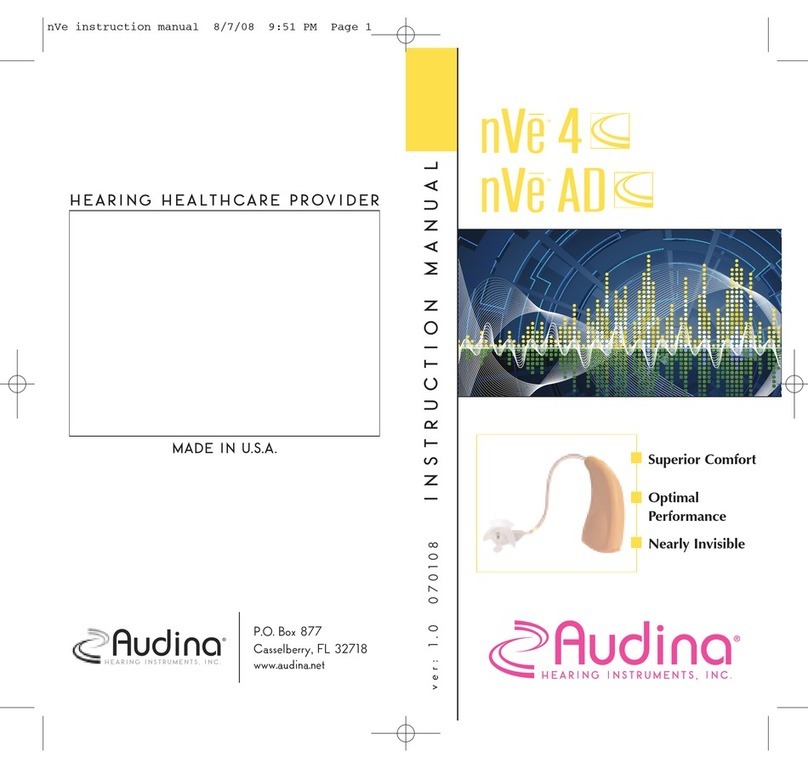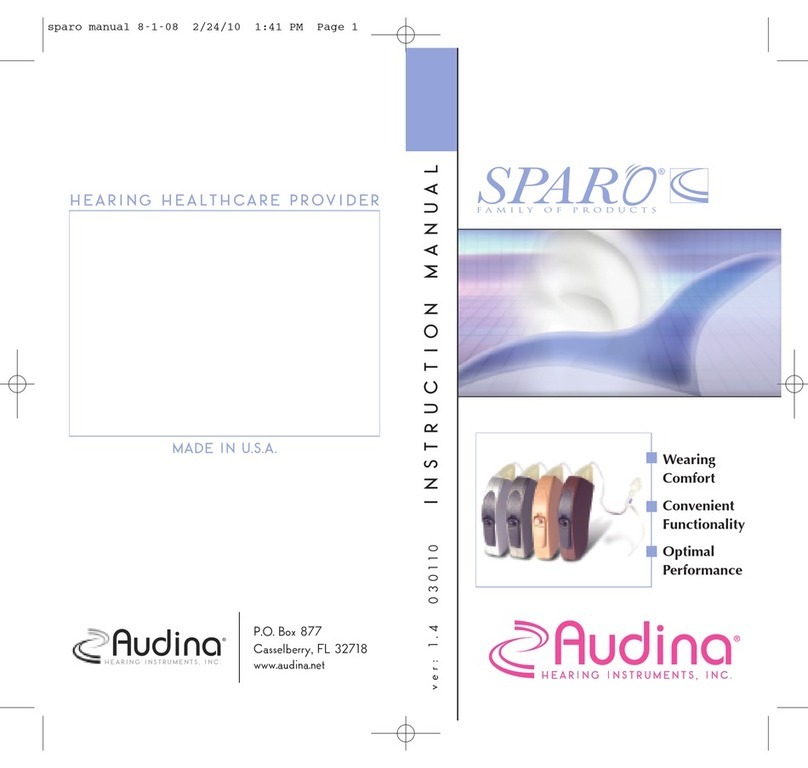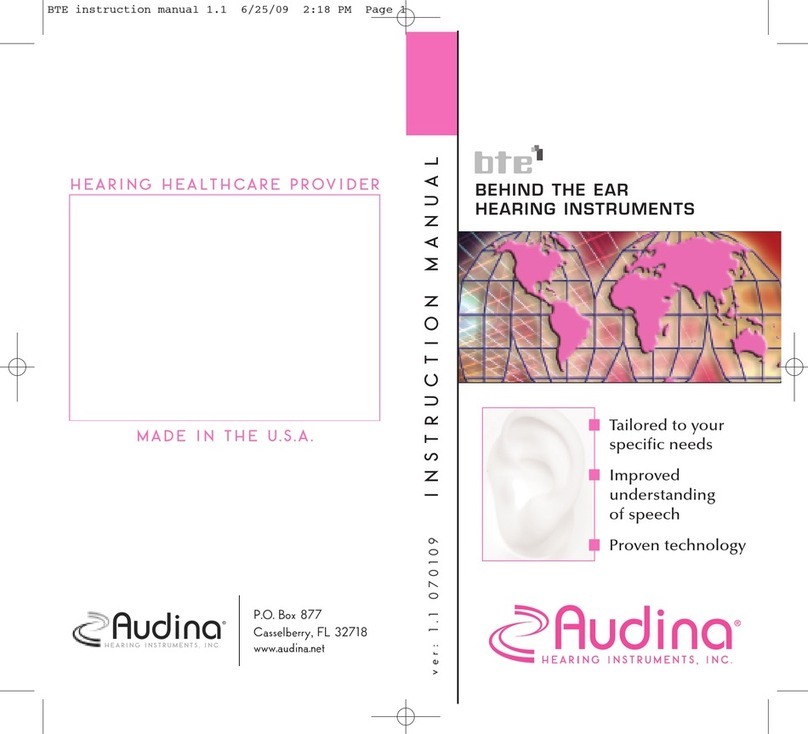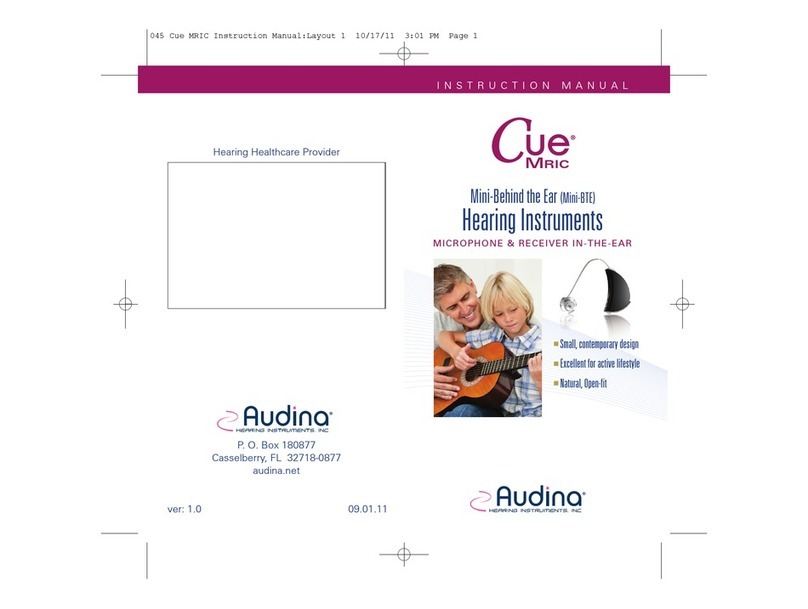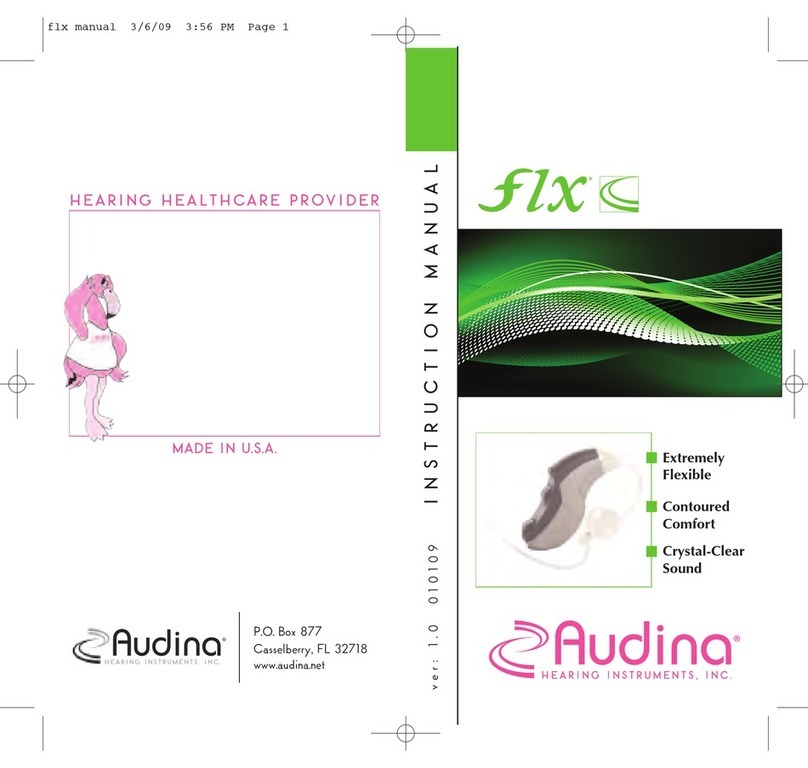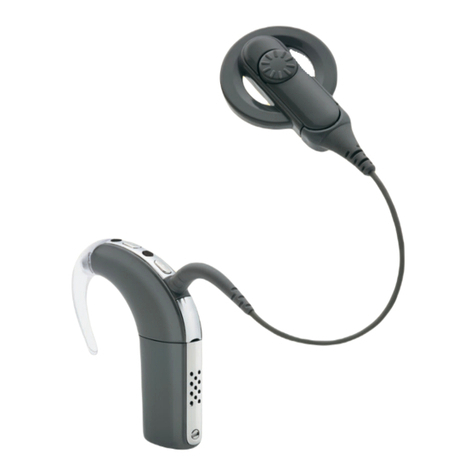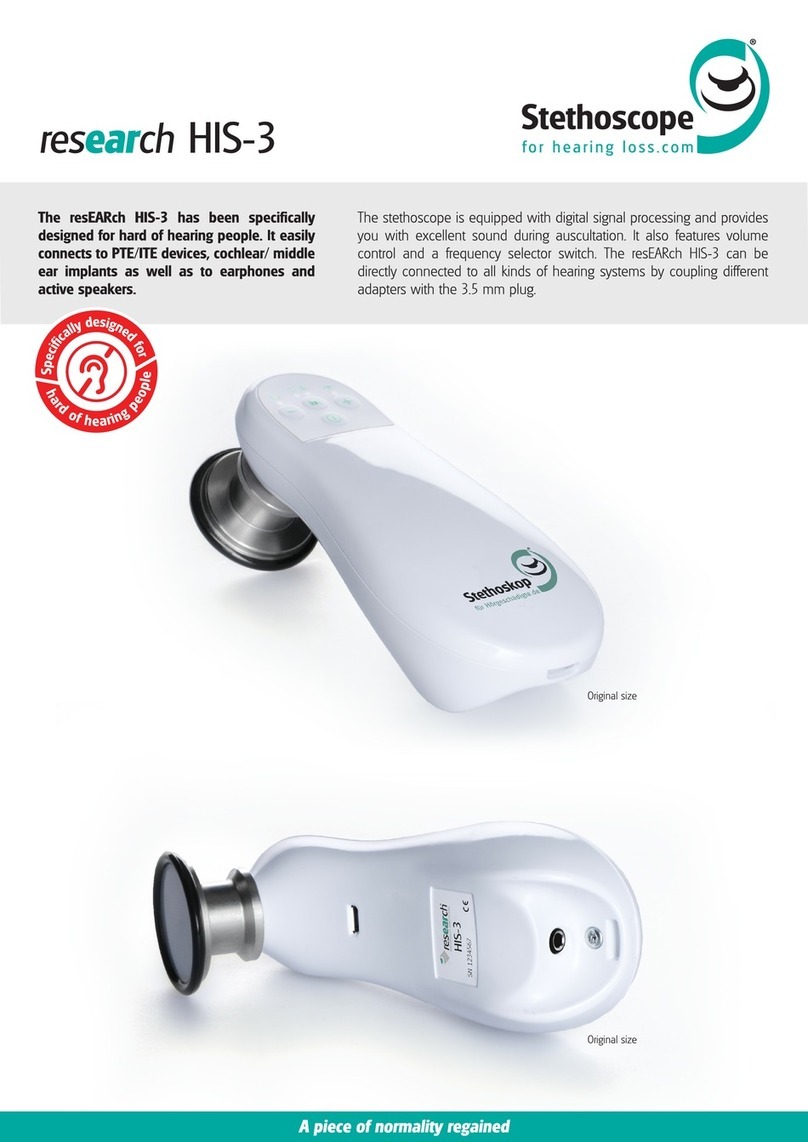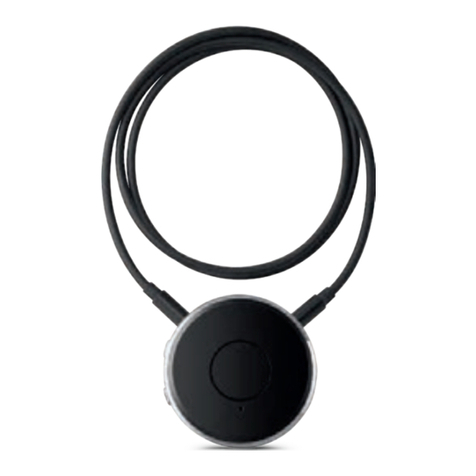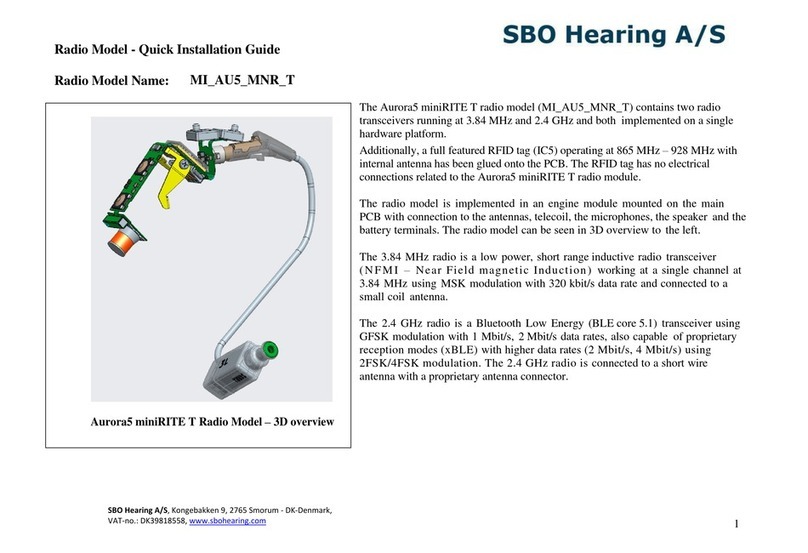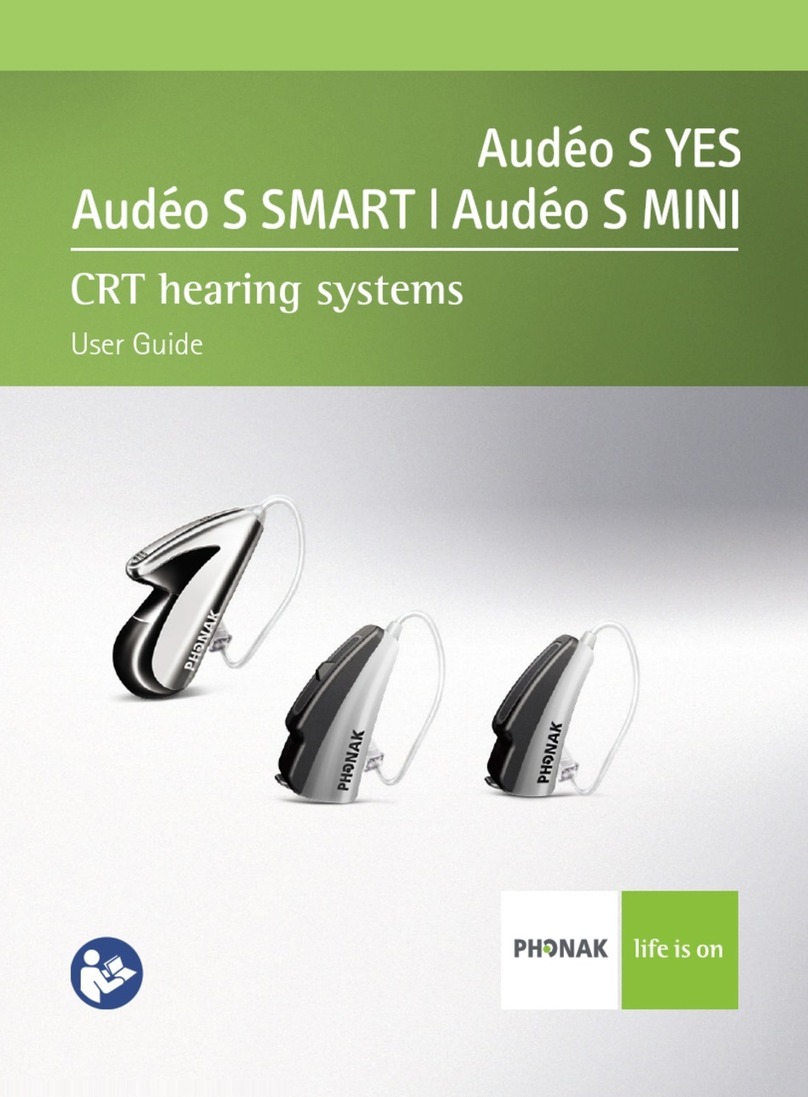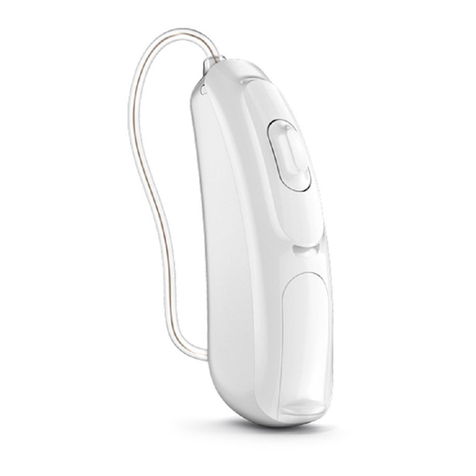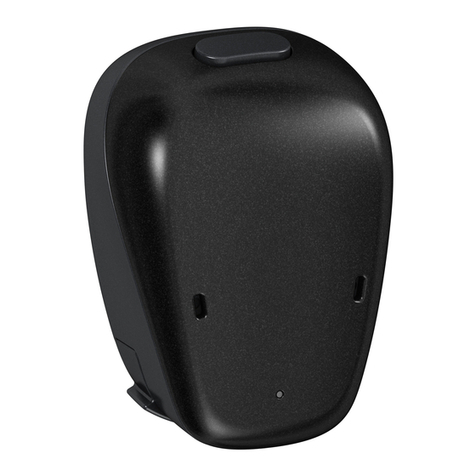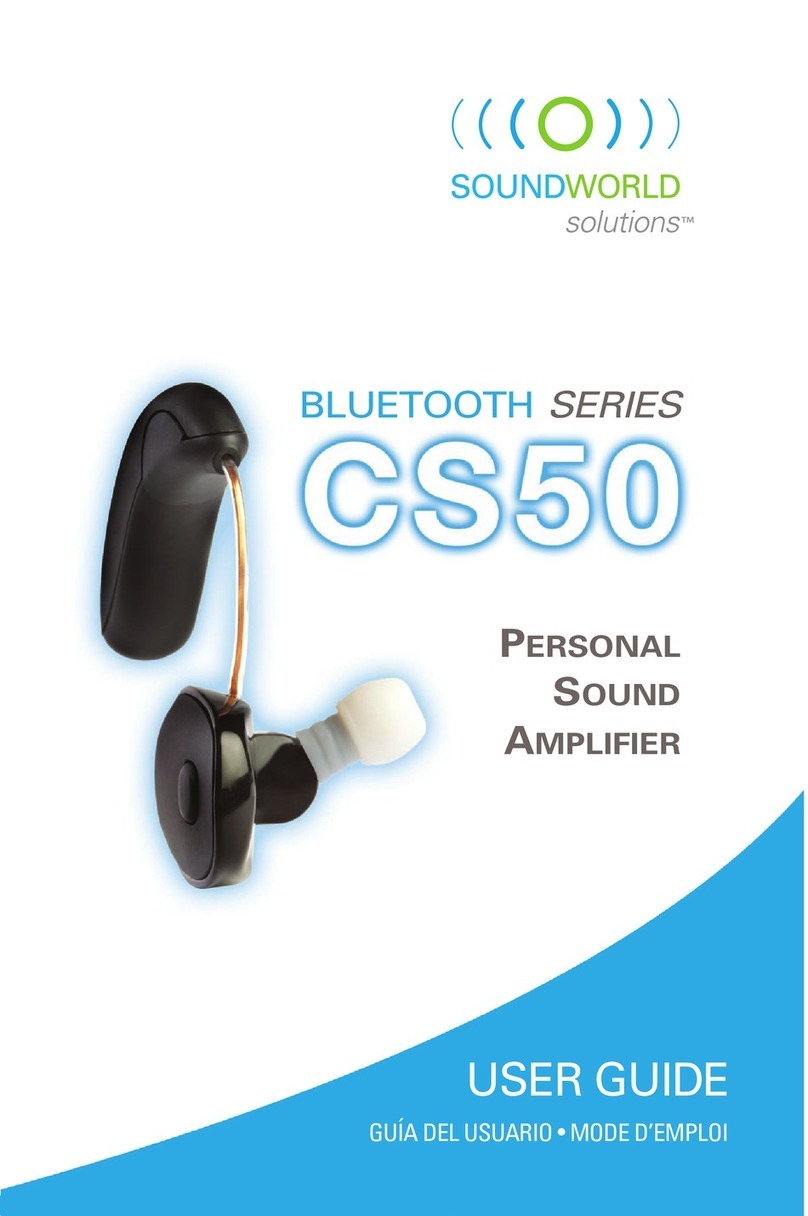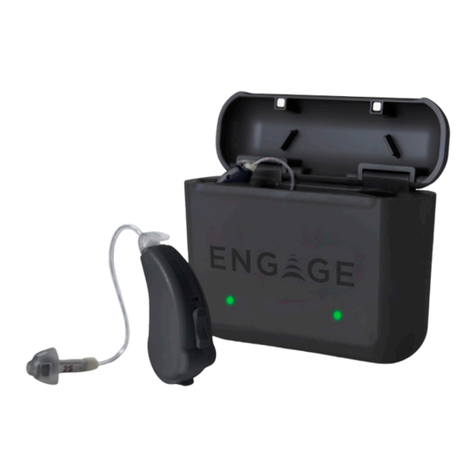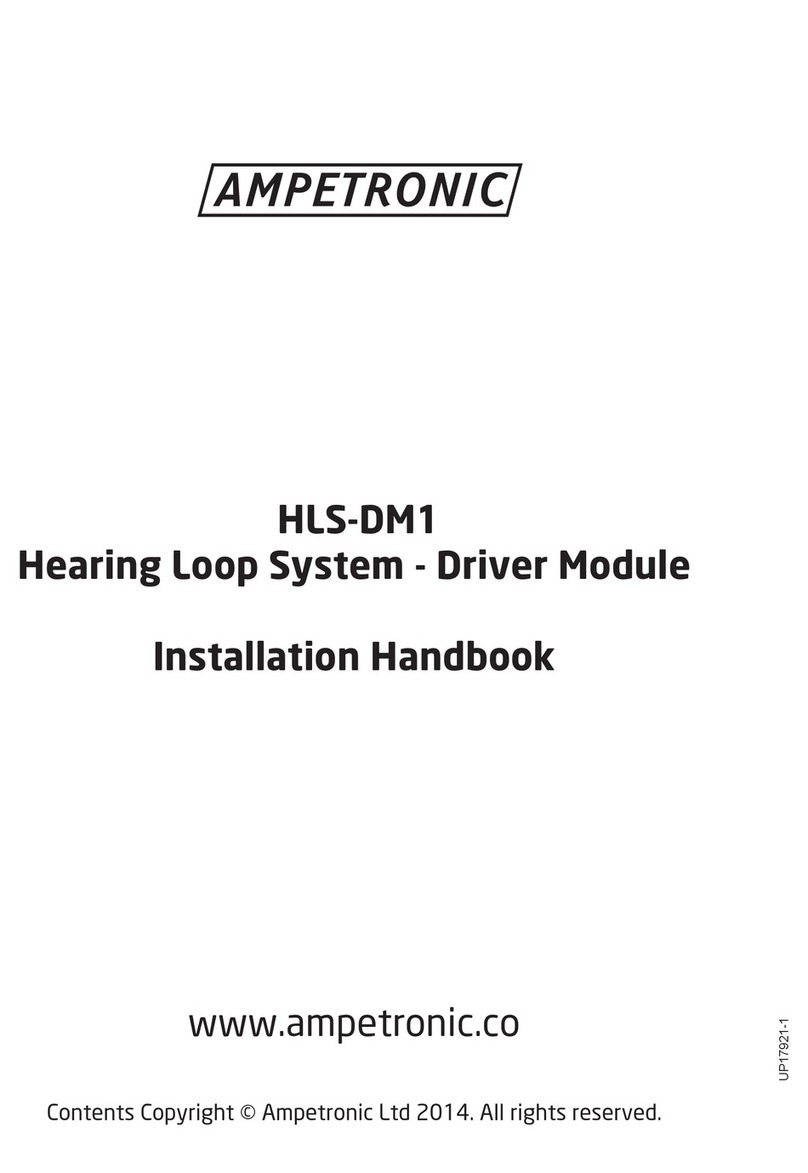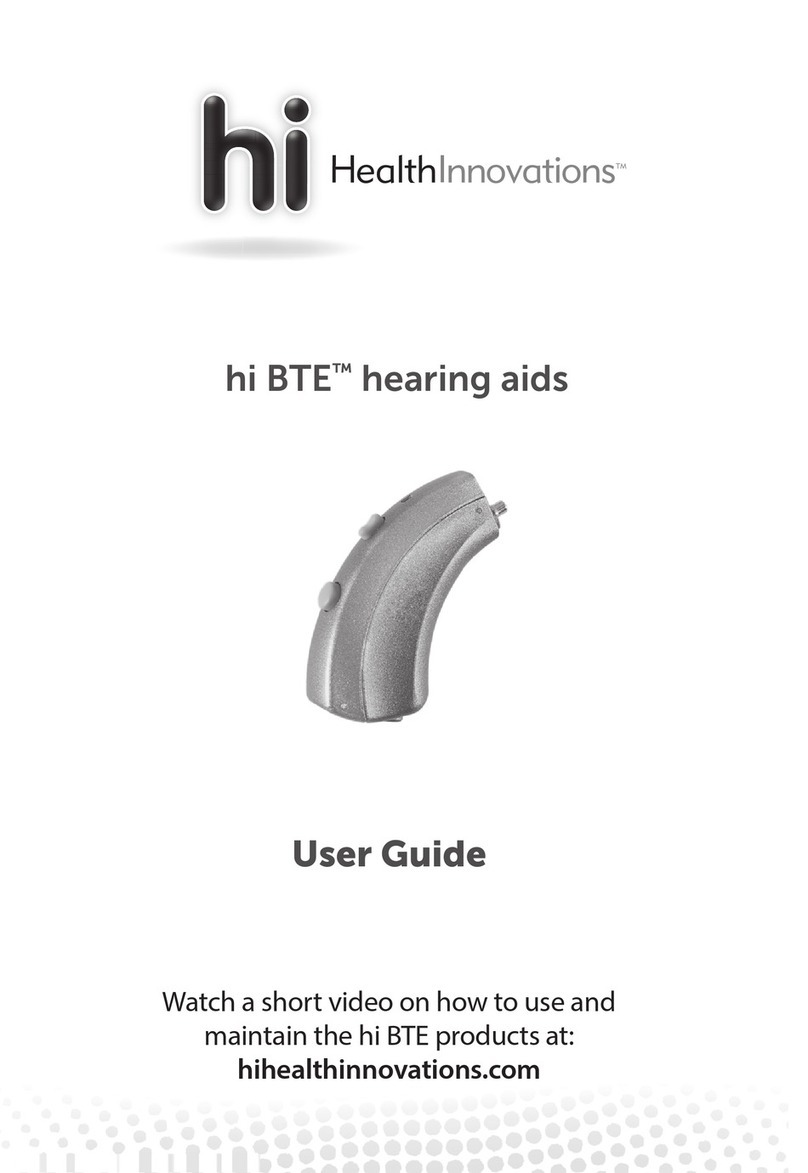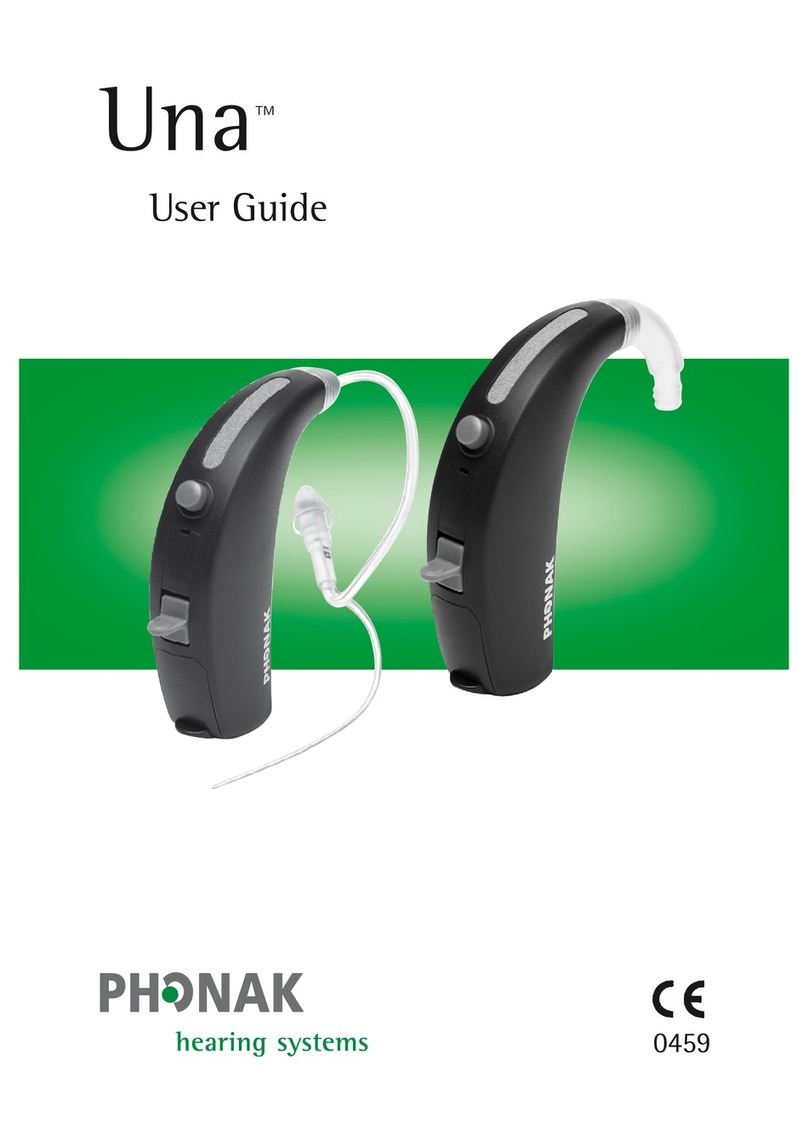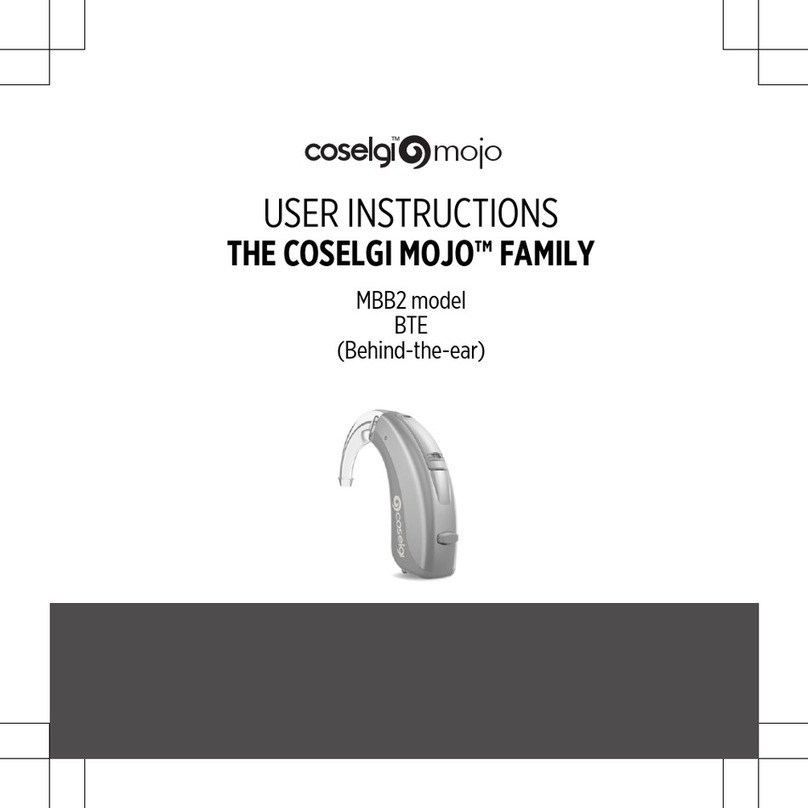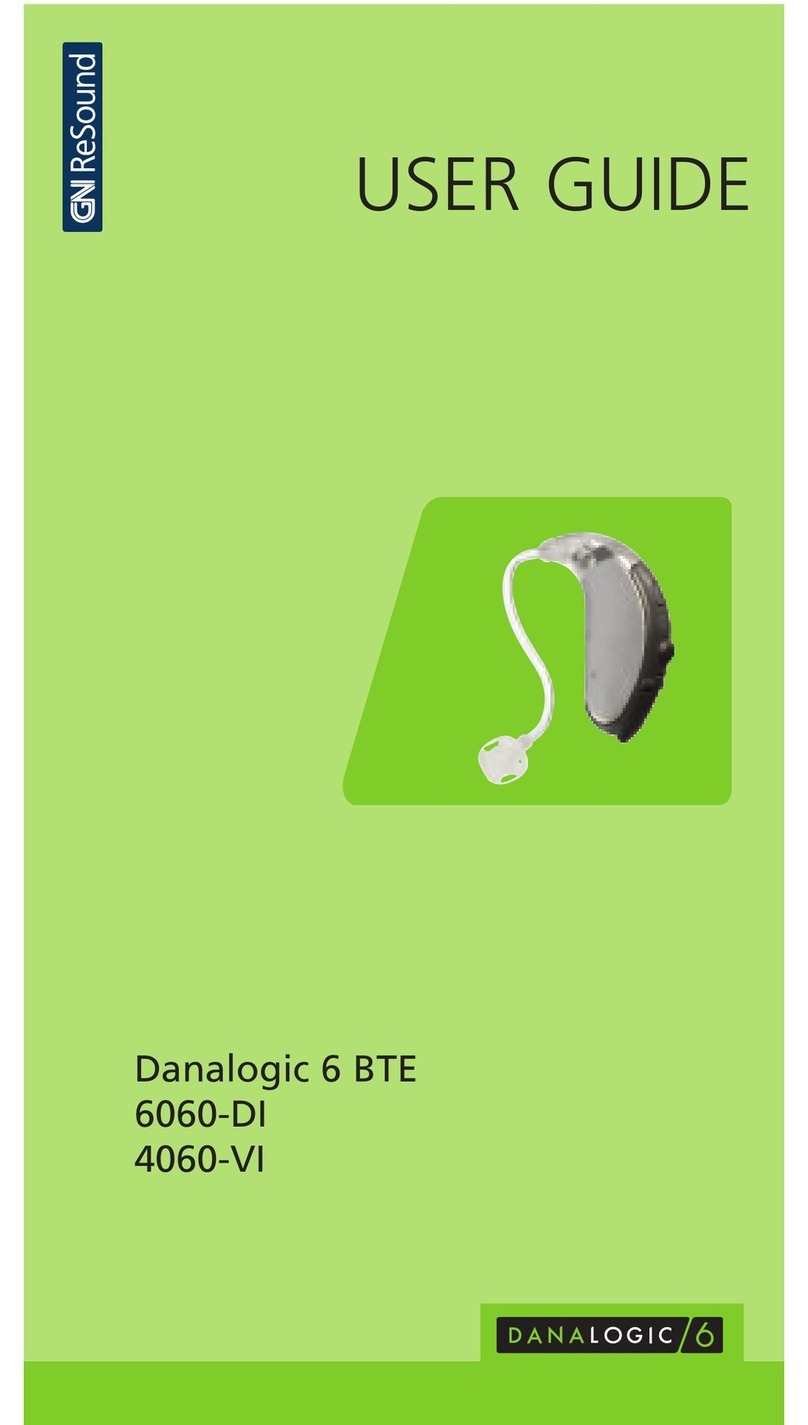Audina CUE User manual

ver: 1.0 04.01.11
Totally Invisible Custom
Hearing Instruments
■Exclusive SoftTouch™
Technology
■Discreet Custom Fit
■Extremely Comfortable
Hearing Healthcare Provider
Made in U.S.A.
P. O. Box 877
Casselberry, FL 32718-0877
audina.net
INSTRUCTION MANUAL
025 Cue Instruction Manual:Layout 1 3/31/11 10:12 AM Page 1

Totally Invisible
Custom Hearing
Instruments
®
025 Cue Instruction Manual:Layout 1 3/31/11 9:19 AM Page 3

i
We understand that hearing loss affects
one’s quality of life. That is why we are
dedicated to building the highest quality
hearing instruments. Your new custom
hearing instruments will soon be
indispensable to you and will bring new
pleasure and enjoyment to your life.
Our company was established in 1990 and
is well-known internationally for offering
high quality, reliable, state-of-the-art
technology. These custom hearing
instruments have been programmed
or adjusted to your individual hearing
loss to precisely fit your hearing and
communication requirements. If necessary,
your hearing healthcare provider may make
further modifications to enhance your
listening experience.
A period of adjustment may be needed to
become accustomed to your new hearing
instruments and the renewed world
of sounds you will experience. The
adjustment time varies for each individual
and may be as little as a couple of weeks to
as long as several months. Allow yourself
time to become familiar with those sounds
you have not heard for a long time.
Before operating your hearing instruments,
please read this manual thoroughly.
Welcome to a world of better hearing!
025 Cue Instruction Manual:Layout 1 3/31/11 9:19 AM Page 5

iii
Inserting Hearing Instruments . . . . . . . . 1
On/Off Function . . . . . . . . . . . . . . . . . . . 1
SoftTouch Technology . . . . . . . . . . . . . . 1
Battery Information . . . . . . . . . . . . . . . . 2
Telephone Use . . . . . . . . . . . . . . . . . . . . 5
Cell Phone Compatibility . . . . . . . . . . . . 5
Cleaning . . . . . . . . . . . . . . . . . . . . . . . . . 7
Care and Storage . . . . . . . . . . . . . . . . . . 8
Do’s and Don’ts . . . . . . . . . . . . . . . . . . . 9
Troubleshooting . . . . . . . . . . . . . . . . . . 11
Binaural Amplification . . . . . . . . . . . . . . 13
Serial Numbers . . . . . . . . . . . . . . . . . . . 14
Warranty Information . . . . . . . . . . . . . . 15
Service and Repair Information . . . . . . 17
Children with Hearing Loss . . . . . . . . . 18
Notice to Perspective Users . . . . . . . . . 19
Notice to Healthcare Providers . . . . . . . 20
Owner Information . . . . . . . . . . . . . . . . 22
Table of Contents
025 Cue Instruction Manual:Layout 1 3/31/11 9:19 AM Page 7

touch, double touch or cover and touch.
Your hearing healthcare professional will
program the instrument during your initial
fitting for the style of touch you prefer.
1 2
These digital hearing instruments have
been custom made for your ears; they
should fit comfortably and easily. When
preparing to insert the instrument into your
ear, position it so the white dot is at the top
and the pull string is at the bottom. Your
hearing healthcare provider will provide
instruction on proper insertion and removal.
Inserting Your Digital Hearing Instrument
Your digital hearing instruments are
equipped with a low battery indicator with
a unique acoustic fade feature. When the
battery in your hearing instrument is low,
you will hear a series of warning tones a
few minutes before the battery goes dead.
It is recommended that you install a fresh
battery at this time.
To replace your hearing instrument battery,
follow these steps:
Step 1:
Lift the notch at the edge of the battery
compartment and swing open the door.
Remove the used battery.
Battery Information
To turn your hearing instrument “on”, you
simply need to close the battery door after
inserting a battery. To turn your hearing
instrument “off”, open the battery door
completely. This will disengage the battery
and turn off the hearing instrument.
In fact, when the hearing instrument is not
in use, it is recommended that you open
the battery door and remove the battery.
This helps to prevent excessive battery
drain and allows for proper ventilation of
the hearing instrument.
On/Off Function
With a simple touch to your ear, SoftTouch
allows you to change memories for up to
four different listening environments. Your
Cue instrument may be set for a single
SoftTouch™Technology
025 Cue Instruction Manual:Layout 1 3/31/11 9:19 AM Page 9

3 4
Step 2:
Remove the colored tab on the new
battery, and insert with + side up.
The life of your hearing instruments’
batteries will vary depending on length of
daily use, listening environments, and how
your hearing instruments are programmed.
When the hearing instrument batteries
go dead, remove them immediately and
replace them with new batteries. Batteries
may be purchased through your hearing
healthcare professional.
When your hearing instruments are not
in use, open the battery compartment
to prevent excessive battery drain and
ventilate the instruments.
Important: Always discard used batteries.
Small batteries can be harmful if
swallowed. Keep batteries out of the
reach of pets and small children. In case
of ingestion, contact your physician or
call the National Button Battery Hotline at
202.625.3333.
Step 3:
Swing the door into
the closed position.
The compartment
should close easily.
Do not force it. If
resistance is noted,
check that the
battery is inserted
correctly.
025 Cue Instruction Manual:Layout 1 3/31/11 9:19 AM Page 11

5 6
Unless your hearing loss is severe
enough to require the use of an amplified
telephone, while wearing the Cue®, you
should not have any problems using the
phone as you would without hearing aids.
If you do experience a slight “whistling”
sound, simply move the telephone slightly
away from your ear.
Telephone Use
Some hearing aid
users have reported
a buzzing sound in
their hearing aids
when they are
using cell phones,
indicating that the
cell phone and
hearing aid may
not be compatible.
According to
the ANSI C63.19
standard (ANSI C63.19-2006 American
National Standard Methods of
Measurement of Compatibility Between
Wireless Communications Devices and
Hearing Aids), the compatibility of a
particular hearing aid and cell phone can
Cell Phone Compatibility
be predicted by adding the rating for the
hearing aid immunity to the rating for the
cell phone emissions. For example, the
sum of a hearing aid rating of 2 (M2/T2)
and a telephone rating of 3 (M3/T3) would
result in a combined rating of 5. Any
combined rating that equals at least 5
would provide “normal use;” a combined
rating of 6 or greater would indicate
“excellent performance.”
The immunity of this hearing aid is at
least M2/T2. The equipment performance
measurements, categories and system
classifications are based upon the best
information available but cannot guarantee
that all users will be satisfied.
NOTE: The performance of individual
hearing aids may vary with individual cell
phones. Therefore, please try this hearing
aid with your cell phone or, if you are
purchasing a new phone, be sure to try
it with your hearing aid prior to purchase.
For additional guidance, please ask your
cell phone provider for the booklet entitled
“Hearing Aid Compatibility with Digital
Wireless Cell Phones.”
025 Cue Instruction Manual:Layout 1 3/31/11 9:19 AM Page 13

7 8
You should inspect your hearing
instruments daily and clean them
periodically to control wax buildup. To
clean, very gently wipe the surface with
a soft, dry cloth or moist cleaning wipes
made especially for hearing instruments.
Do not allow water or liquid to enter any
openings on the instruments.
Inspect the tip of the ear canal portion
of the hearing instruments for any wax
buildup. Using only the wax tool supplied,
carefully remove any wax from around the
sound outlet as directed by your hearing
healthcare provider. Be very careful not to
push wax into the opening or to insert the
tool deeply into the opening.
The wearing of an earmold or in-the-ear
hearing instruments may accelerate the
accumulation of ear wax. This can easily
be removed by your physician or in some
cases your hearing healthcare provider. You
should not use cotton swabs to clean your
ears, due to the risk of pushing the wax
deeper into the ear canal.
Cleaning Your Hearing Instrument
Hearing instruments are exposed to
moisture in the form of humidity and
perspiration while being worn. The daily
use of a dehumidifying system or drying
kit approved by your hearing healthcare
provider is recommended. These
accessories may be purchased from
your hearing healthcare provider.
The most common causes of hearing aid
repair are wax and moisture. If you are
encountering recurrent repairs, please
discuss the various wax/moisture
prevention systems and accessories with
your hearing healthcare provider.
Care and Storage
The materials used in your hearing instru-
ments are of the highest quality available,
and the likelihood of an allergic reaction is
slight. If a skin irritation occurs, including
redness, swelling or itching where the
hearing aid makes contact with your
ear – contact your physician and hearing
healthcare provider.
025 Cue Instruction Manual:Layout 1 3/31/11 9:19 AM Page 15

910
Extended Storage:
If it is necessary to store your hearing
instruments for an extended amount of
time, follow the steps below for proper
storage.
1. Remove the batteries.
2. Clean the instrument according to
instructions on previous pages.
3. Place the instruments in a cool, dry
place. Either their original container or
a hearing instrument dehumidifier is
recommended.
Do store the instruments overnight in a
hearing aid dehumidifier to absorb
moisture (Be sure and remove
batteries first).
Do always carry spare batteries.
Do replace the battery when the
low-battery warning begins.
Do always care for your instrument as
outlined in this manual.
Do dry the battery contacts with a cotton
swab in cases of humid weather or
heavy perspiration.
Do safely store hearing instruments when
not in use. Keep them out of the reach
of small children and pets.
The Do’s and Don'ts of Hearing Instruments
Do remove your hearing instruments if you
are going to have X-rays at your dentist
or medical facility. It is best to keep
them outside the room of the X-ray
equipment.
Don’t leave your hearing instruments on
the radiator, near a stove, in a sunny
window, in a car or in any other hot
place. Excessive heat and cold can
damage the instruments.
Don’t wear the hearing instruments when
using a hair dryer at home or when at
the beauty salon, spa or barber.
Don’t wear the hearing instruments when
having medical tests done such as
MRI, X-rays or CT scans; as different
types of radiation may damage the
hearing instrument.
Don’t apply hair spray when wearing your
hearing instruments. It may damage
the microphone and erode the case.
Don’t wear the instruments while taking a
bath, shower, spa treatment or while
swimming.
Don’t store the instruments in the
bathroom during a shower or near a
steam room as moisture created by
the steam may cause damage.
025 Cue Instruction Manual:Layout 1 3/31/11 9:19 AM Page 17

11 12
No Sound:
■Ensure that hearing instruments are
turned on.
■Replace the battery.
■Ensure that there is no wax or debris
in the sound channel.
Not loud enough:
■Replace the battery.
■Ensure that there is no wax or debris
in the sound channel.
■Ensure that hearing instruments are
completely seated in the ear canal.
■Excessive earwax can prevent sound
from entering the ear. Contact your
physician or hearing healthcare
provider.
■Changes in your hearing loss can
affect how you hear with a hearing
aid. Contact your hearing healthcare
provider if you suspect any change in
your hearing status.
Whistling / Feedback:
■Ensure that hearing instruments are
completely seated in the ear canal.
■Excessive earwax, improperly sized
instruments, and large vents can
cause whistling. Contact your hearing
healthcare provider.
Sound is Distorted or Unclear:
■Replace the battery.
■Hearing instruments may have a
poor battery contact or may not be
programmed properly. Return to your
hearing healthcare provider.
Intermittent Sound:
■Replace the battery.
■Ensure that there is no wax or debris
in the sound channel.
■Hearing instruments may have a poor
battery contact. Return to your hearing
healthcare provider.
Too Much Bass:
■Ensure vent is clear.
■Hearing instruments may need
reprogramming. Return to your hearing
healthcare provider.
Static Noise:
■Replace the battery.
■If you are near an electromagnetic
field (i.e. near a computer screen or
fluorescent lights), step away to see
if the static clears.
■Hearing instruments may have a poor
battery contact. Return to your hearing
healthcare provider.
Troubleshooting Guidelines
025 Cue Instruction Manual:Layout 1 3/31/11 9:19 AM Page 19

Each hearing instrument has its own
unique number located on the exterior of
the hearing aid.
Blue writing or blue coloring denotes a left
hearing instrument. Red writing or red
coloring denotes a right hearing instrument.
The first two digits of the serial number
represent the year in which the instrument
was manufactured. The second two digits
of the serial number represent the month
in which the hearing instrument was
manufactured.
Interpretation of Serial Number
1413
Hearing loss can be improved, in most
cases, through medicine, surgery, or with
hearing instruments. Hearing aids are the
most commonly chosen option.
Today’s hearing instruments are quite small
in size and feature sophisticated electronics
that accommodate a wide variety of
hearing losses. Nature gave us two ears for
a reason and since the majority of people
who have a hearing loss are affected
in both ears, two (binaural) hearing
instruments are typically recommended.
Two hearing instruments should provide
these benefits:
■Better overall sound quality when
compared to one hearing instrument
(“stereo sound”).
■The ability to locate a sound source in
noisy and normal listening conditions.
■Increased ability to understand
speech in noisy and normal listening
conditions.
■A sensation of balanced hearing.
Talk with your hearing healthcare provider
about what is best for you. Even the best
technology can’t do the work of two ears!
Binaural Amplification
Name of Aid & Company
CUE
06-030010
Denotes
Year
Denotes
Month
025 Cue Instruction Manual:Layout 1 3/31/11 9:19 AM Page 21

1615
Please see your hearing healthcare
provider regarding your specific warranty
information. Our guarantee covers any
defect in material or faulty production,
except cords and batteries. We will, at our
option, repair or replace the instruments or
any defective part, at our expense, within
the limits of the warranty.
This warranty will become invalid if your
hearing instruments have been tampered
with or altered in any way, or if the serial
number has been altered, effaced, or
removed, or if any repairs have been
made without authorization.
This warranty does not include a promise
of specific hearing improvement because
that depends upon your audiologic needs,
proper fitting and adjustments by your
hearing healthcare provider and proper use
by the owner.
Any implied warranty shall be limited to
one year from date of purchase. The only
entity or individual who is authorized to
perform the warranty obligations is the
manufacturer. All in-house warranty work
performed by the manufacturer will be
Warranty Information
done within a reasonable period of time.
If warranty work is performed and there
appears to be a defect, malfunction, or
failure to conform to the warranty, the
obligations will be met if brought to our
attention within one month from the date
of the original warranty work.
This warranty is specifically limited to the
scope set forth herein, and may not in
any way be expanded by the other oral or
written representations.
025 Cue Instruction Manual:Layout 1 3/31/11 9:19 AM Page 23

1817
Children with Hearing Loss
You should visit your hearing healthcare
provider if your hearing instruments are in
need of service. If you no longer have a
hearing healthcare provider and are in need
of one, you may contact Audina and we will
assist you in finding one in your area. If you
are unable to visit a hearing healthcare
provider, you may send your hearing aids
directly to the manufacturer.
Before planning to return your instruments
for repair, please refer to the troubleshoot-
ing chart on the proceeding page. Many
times these solutions can prevent the time
and cost associated with a repair.
If you need to send your instruments
directly to the manufacturer, carefully pack
your instruments in a sturdy box and send
it to:
Audina®Hearing Instruments, Inc.
P. O. Box 877
Casselberry, FL 32718-0877
You must include your current phone
number and home address. There is a $40
charge to cover shipping and handling.
Please include a check, payable to Audina
Hearing Instruments, Inc. for said amount
when sending your instruments for service.
Service and Repair Information It is recommended to purchase shipping
insurance when sending your hearing aids
to the manufacturer.
If your hearing instruments are out of
warranty, we will assist you in finding
a hearing healthcare provider in your
local area.
In addition to seeing a physician for a
medical evaluation, a child with a hearing
loss should be directed to an audiologist for
evaluation and rehabilitation since hearing
loss may cause problems in language
development and the education and social
growth of a child. An audiologist is qualified
by training and experience to assist in the
evaluation and rehabilitation of a child with
hearing loss.
025 Cue Instruction Manual:Layout 1 3/31/11 9:19 AM Page 25

2019
Notice to Prospective Users
Good health practice requires that a person
with a hearing loss have a medical exam
by a licensed physician, who specializes in
diseases of the ear, before purchasing a
hearing instrument.
Licensed physicians who specialize in the
diseases of the ear are often referred to as
Otologists, Otolaryngologists (ear, nose and
throat – ENT) or Otorhinolaryngologists.
The purpose of a medical evaluation is
to assure that all medically treatable
conditions that may affect hearing are
identified and treated before the hearing
instrument is purchased. Following the
medical evaluation, the physician will give
you a written statement that your hearing
loss has been medically evaluated and that
you may be considered a candidate for a
hearing instrument.
A hearing specialist will conduct an
evaluation to assess your ability to hear.
The hearing instrument evaluation will
enable the hearing specialist to select and
fit a hearing instrument to your individual
needs. Federal law restricts the sale of
hearing instruments to those individuals
who have obtained a medical evaluation
from a licensed physician.
Federal law allows a fully informed adult
to sign a waiver statement declining the
medical evaluation for religious or personal
beliefs that preclude consultation with a
physician. The exercise of such a waiver is
not in your best interest, and its use is
strongly discouraged.
Notice for Hearing Healthcare Providers
Hearing healthcare providers should advise
a prospective hearing instrument user to
consult promptly with a licensed physician
(preferably an ear specialist) before
dispensing a hearing instrument if the
hearing healthcare provider determines
through inquiry, actual observation, or
review of any other available information,
that the prospective user has any of the
following conditions:
■Visible congenital or traumatic deformity
of the ear.
■History of active drainage from the ear
within the previous 90 days.
■History of sudden or rapidly progressive
hearing loss within the previous 90 days.
■Acute or chronic dizziness.
■Unilateral hearing loss of sudden or
recent onset within the previous 90 days.
025 Cue Instruction Manual:Layout 1 3/31/11 9:19 AM Page 27

2221
■Audiometric air-bone gap greater than or
equal to 15 decibels at 500 hertz (Hz),
1000 Hz, and 2000 Hz.
■Visible evidence of significant cerumen
(wax) accumulation or a foreign body in
the ear canal.
■Pain or discomfort in the ear.
Special care should be exercised in
selecting and fitting a hearing instrument
which has a maximum sound pressure
level in excess of 132 dB (decibels)
because there may be a risk of damaging
the remaining hearing of the hearing
instrument user.
Owner Information
MODEL:
SERIAL NUMBERS:
LEFT:
RIGHT:
PURCHASE DATE:
BATTERY SIZE:
ORIGINAL WARRANTY EXPIRES:
HEARING HEALTH CARE PROVIDER:
025 Cue Instruction Manual:Layout 1 3/31/11 9:19 AM Page 29

23
Notes
025 Cue Instruction Manual:Layout 1 3/31/11 9:19 AM Page 31
Table of contents
Other Audina Hearing Aid manuals

